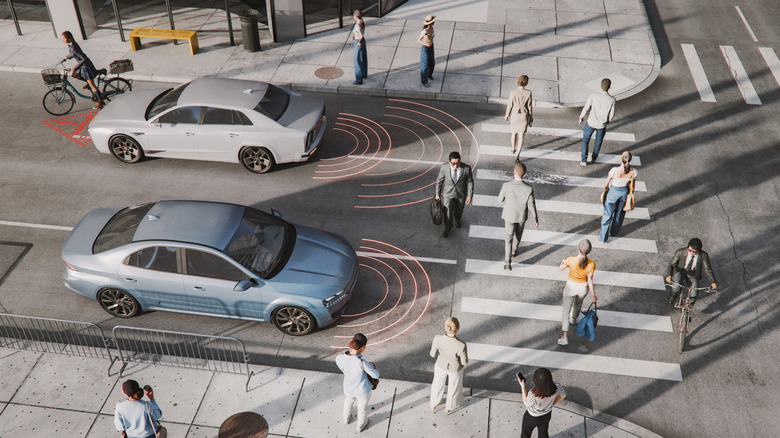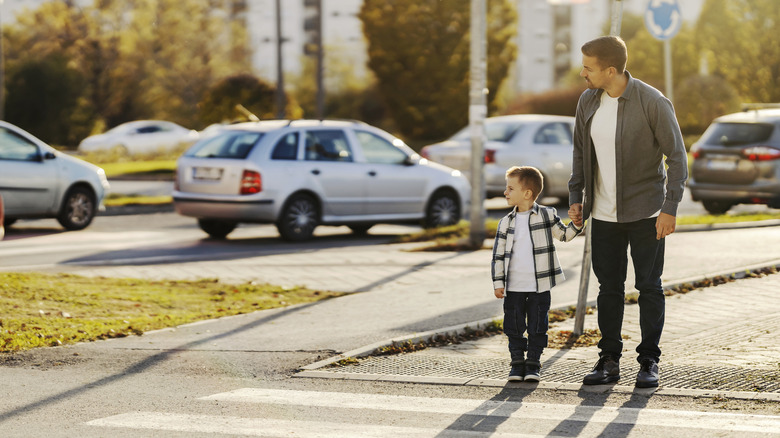US Government Proves It Cares More About Cars Than Pedestrian Safety
Various cities around the United States are slowly but surely becoming more pedestrian-and bike-safe, with implementations like e-bikes in major centers such as New York City — but this is more of a de facto trend. You wouldn't recognize it if you were to look at the laws centered on the American automotive industry, which naturally tend to favor cars above all else. In a country where high-speed rail is more of a pipe dream than anything and many roads don't even have sidewalks to begin with, cars are still the predominant means of travel, often creating not just an exclusionary environment for pedestrians but a downright hostile one.
America is the land of pickup trucks with hoods so high that it's nearly impossible to see a grown adult walking across the street, much less children. It's the land of vehicles like the Cybertruck, deemed so unsafe that you can't legally drive one in Europe. But this is (debatably) less about outright unsafe design practices as it is about cost; for instance, pickup trucks are so huge because their size means they aren't subjected to as stringent emissions restrictions as normal-sized passenger cars. Similarly, manufacturers are sometimes reluctant to add safety equipment because of cost issues, development time, and so on — sometimes even lobbying to prevent such changes for a year or more.
That's exactly what's happening here. According to a recent report by Reuters, automakers asked the National Highway Traffic Safety Administration (NHTSA) to hold off on changes it's making to its five-star safety rating program, which would negatively impact these companies.
The proposed changes and why they're being delayed
The majority of these proposed changes center around the inclusion of new automated systems for detection and avoidance, including blind spot warning and intervention sensors, lane-keeping assist, and pedestrian-detecting automatic braking. It has been argued that such systems must be robust enough that the cars can detect a stationary object and stop from 62 mph (100 km/h) before hitting it, a target which companies like Volkswagen Auto Group and General Motors say is "unrealistic," according to the Reuters article. These companies all fall under the collective Alliance for Automotive Innovation, a conglomerate including other major firms like Ford, Toyota, Nissan, Kia, Isuzu, and more. Effectively, it's most major brands you see on the road today saying they can't build a car that'll stop in time if it detects an obstacle on the road when going the speed limit.
Apparently, these pleas worked because the NHTSA announced that the changes will be delayed until 2027, giving these automakers time to redesign their vehicles to comply with the new restrictions. That may be a good thing, because the last thing any car manufacturer wants to bug fix is a car's safety systems, unless they particularly love lawsuits or massive recalls like one of the worst in history.
The reason why these changes are so important to automakers revolves around that coveted five-star NHTSA rating, which is often a selling point for families and first-time buyers alike. We as consumers are more spoiled for choice than ever before, and unlike the labyrinth of electronics and mechanical components, which may or may not be reliable, safety is far easier to understand, generally speaking. Safety sells, so car manufacturers do just enough to earn the rating and, therefore, the profit.
What this means for you
Critics have stated that the NHTSA's actions were especially callous for a number of reasons. For instance, the 2024 NHTSA report simply neglected to publish any documentation concerning pedestrian safety in general, demonstrating a fundamental lack of priorities at the government level concerning people not in cars. This also handicaps automakers, since how would they know what is and isn't an issue to be addressed without the relevant data to back it up?
Fundamentally, this means that not much will change, at least not for the next couple of years, in terms of overarching vehicle safety in the U.S. Regulations surrounding the safety standards will stay the same, likely not because of any outright malice, but because of the demands for sufficient research and development time to build these vehicles correctly. Arguably, the most taxing thing to actually implement will likely be the stopping distance, since that requires either having more powerful brakes, less weight, or both, to ensure that the car can stop in time before it strikes an obstacle.
There are several cars that are ahead of the curve (and many lagging well behind it), with multiple examples scoring over 9/10 with U.S. News, for instance; however, many of these models feature no reverse automatic braking. Such systems require separate LIDAR sensors and all the electronics to make it work, jacking up costs for what isn't strictly necessary from an automaker's perspective. We'll wait to see if that changes in 2027.


